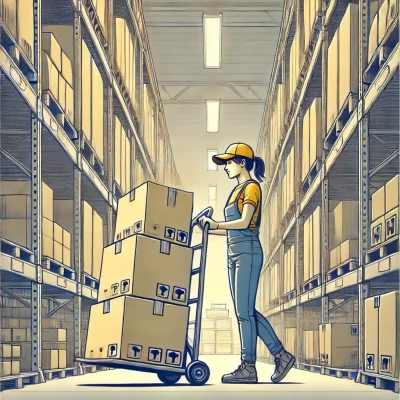Are you encountering bottlenecks in your production process? Are you getting behind on-demand and deliverables? You need to streamline your workflow to stay competitive in today’s rapidly evolving market. We’ll examine how to identify bottlenecks and streamline your sourcing in your production process.
What Is the Importance of Workflow?
Workflow streamlines and improves employee productivity and business processes. This is particularly true for repeatable business processes that can be automated for efficiency and speed. Continually improving workflow enables a business to:
- Clarify the top-level view of the business as well as for individual business processes.
- Identify redundancies and bottlenecks in business operations.
- Reduce micromanagement and increase accountability.
- Improve communication between departments.
- Boost customer service
- Enhance the quality and deliverability of products and services
To improve workflow, businesses need to evaluate their overall business structure and operations.
Related Link: What is Inventory Management and Why it’s Important
How to Identify Bottlenecks
Workflow bottlenecks happen when product demand exceeds production capacity. While high demand is a great problem to have as a business, it can lead to lost revenue when processes aren’t in place to compensate for the uptick in demand. Workflow bottlenecks can take many forms, such as:
- Scarce resources
- Legacy equipment and software
- Inefficient labor
You’ll need to evaluate your workforce and your systems to identify bottlenecks. Bottlenecks can generally be categorized as:
- Short-term bottlenecks: These are temporary problems or setbacks that can occur when materials delivered late or critical team members are out of town that backlog tasks or projects.
- Long-term bottlenecks: These bottlenecks are recurring problems that affect business operations because the underlying issue is not being addressed.
While all bottlenecks are a disruption, you’ll want to identify and fix long-term bottlenecks as soon as possible because they can affect sales, product quality, and customer satisfaction.

What Are The Consequences of Manual Processes
In today’s marketplace, manual processes create massive bottlenecks in operations. A recent McKinsey report found that 66% of organizations are pursuing automation in at least one or more functions to remain competitive. You’ll want to evaluate all of your manual processes and look for ways to automate to reduce common bottlenecks.
Stall in Production
A stall in production happens when a machine or process within the production line slows or stops other systems from working. You’ll need to examine each task or process in production for efficiency and possible bottlenecks. Leverage your team that handles that process to brainstorm ways to innovate, eliminate, or automate.
Often in production, organizations are using legacy software, technology, and systems that are outdated and cumbersome. Businesses need to adopt new technology and the Internet of Things (IoT), which are devices that can connect and share data with management systems, to improve production and eliminate bottlenecks.
Supply Overstock
A broken logistics process can lead to an overstock of supply. Overstock requires storage and idle production until the bottleneck is fixed. Depending on your industry, where products may have a short shelf life, supply overstock can dramatically affect costs, shrinkage, product deterioration, and revenue.
To prevent supply overstock, organizations need to invest in a reliable inventory management system that can integrate seamlessly with other systems and collect accurate data.
It’s also important to be aware of consumer trends and calculate reorder points based on customer demand. A third-party logistics provider can alleviate many of these types of bottlenecks.
Want a robust inventory management system that can do more than track inventory? Sign up for a free trial of our advanced inventory operations platform.
Related Link: How Implementing an Automated Inventory Management System Can Save Your Business
Lower Employee Morale
Manual processes can frustrate, anger, and create stress for employees and management. The employee is often bogged down in tedious logistics that can often be automated by better technology, and these manual processes can hold up other team members or production. This can then create resentment and conflict between employees and management.
To encourage and facilitate a better workflow that will increase morale, talk to your management and employees about eliminating or replacing these manual processes where they feel it will improve workflow. Frequently, there are technology systems and software that can help automate many of these tedious tasks.

How to Avoid Bottleneck in your Production Process
Bottlenecks in production can be the most costly because they affect your inventory and ability to meet demand. Thankfully, there are a few methods to reduce or prevent production bottlenecks.
Elevate the Capacity
If you can identify a process that produces lower quantities and creates a bottleneck in the production line, you can increase the capacity by:
- Increasing resources in the form of technology, equipment, or people.
- Automating all or parts of the process.
- Using third-parties to complete production. Note: You’ll want to vet the company to make sure you can maintain quality. This is generally done when demand is seasonal or uneven, and you don’t have a bottleneck during the off-season.
Need a system for visualizing work orders? Learn more about our hassle-free manufacturing management tool that makes allocating work orders a breeze.
Sell the Extra
If you find a process in your production over-produces quantities compared to the rest of the line, you may want to consider selling or subcontracting this process to other companies. As long as you charge more than your variable costs, you’ll create another revenue stream.
Downsize
If you find a production process is over-producing, another alternative is to downsize the equipment or personnel handling that part of the process. This will even out your production quantities and possibly reduce costs.
If downsizing personnel, you may want to move them to another production area where quantities aren’t as high to make the best use of your workforce.
Final Thoughts
Enterprises can find bottlenecks in all aspects of operations. You’ll want to identify and prioritize which bottlenecks are affecting your production workflow the most. Then look for ways to:
- Upgrade equipment and technology
- Automate as many manual processes as possible
- Continually train your workforce to improve their skill level.
When you address bottlenecks, you’ll increase production, product quality, and employee morale. In many cases, using third-party technology and tools can solve long-term bottlenecks. This way, you don’t have to reinvent the wheel every time you hit a stumbling block.
We offer a variety of production management tools to track, manage, source, sell, and manufacture inventory seamlessly. Our modern, easy-to-use system integrates well with existing systems and can track your inventory in real-time, so you’ll be able to meet demand.
Check out Fiddle’s tiered pricing model that can grow with your demand.
Related Link: The Five Features That Manufacturing Inventory Software Needs to Have for Businesses to Scale










